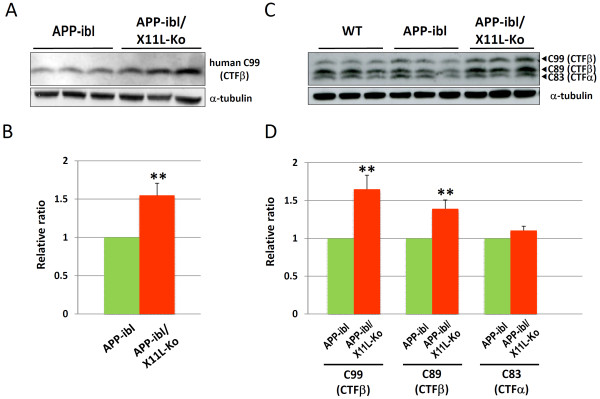Figure 6.
Generation of primary amyloidogenic fragment CTFβ in APP-ibl mice in the presence or absence of X11L. (A) Generation of human CTFβ in APP-ibl mice in the presence or absence of X11L. Brain regions composed of the cerebral cortex, hippocampus and olfactory bulb from APP-ibl and APP-ibl/X11L-Ko mice (4 months old) were homogenized in 10 mM Tris-HCl [pH 7.9] containing 1% (w/v) SDS, 4 M urea, complete protease inhibitor cocktail (Roche Diagnostics), and 1 μM pepstatin. The lysates were dephosphorylated as described [11,27] and analyzed by immunoblotting with anti-human Aβ (82E1) and anti-α-tubulin antibodies. (B) The density of human CTFβ band was standardized to the density of α-tubulin, which was compared with the ratios for APP-ibl mice that were assigned a reference value of 1.0 (values represent the means ± S.E.). The data were analyzed by Student's t test (n = 10; **, p < 0.01). (C) Generation of CTFα and CTFβ in APP-ibl mice in the presence or absence of X11L. Brain lysates of the cerebral cortex, hippocampus and olfactory bulb from wild-type (WT), APP-ibl and APP-ibl/X11L-Ko mice (4 months old) were dephosphorylated and analyzed by immunoblotting with anti-APP/c 8717 and anti-α-tubulin antibodies. (D) The densities of C99 (CTFβ), C89 (CTFβ) and C83 (CTFα) bands were standardized to the density of α-tubulin, which was compared with the ratios for APP-ibl mice that were assigned a reference value of 1.0 (values represent means ± S.E.). The data were analyzed by Student's t test (n = 10; **, p < 0.01).

